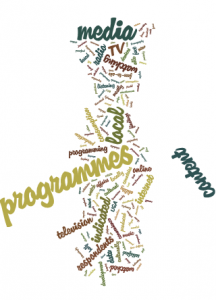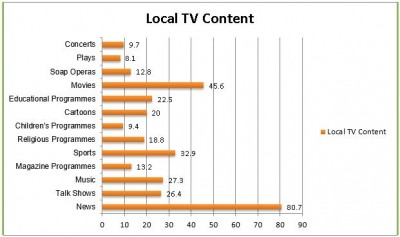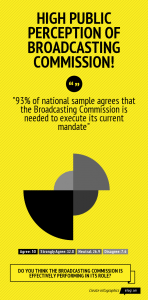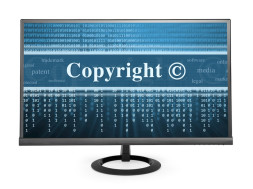
The Broadcasting Commission is tasked with the important responsibility of regulating the electronic communications industry, which comprises the television (free-to-air and cable) and radio sectors. As is well known, media content plays an important role in the formation of values, mores and ideas amongst Jamaicans, and furthermore, also influences political and economic discourse. In view of the important role media play, and the BCJ’s own primary role as a content regulator, the Caribbean Institute of Media and Communication (CARIMAC) was commissioned to conduct a ‘Study of the Output of Jamaica’s Electronic Media Sector Content’. This blog article forays into the findings of that study.
The research project comprised quantitative dimensions including a face-to-face multi-stage nationally representative sample of 1,418 respondents and 647 online respondents. Also quantitative analysis was performed on a sample of television (local cable channels and free-to-air) and radio broadcasts within a two-week period. The qualitative data methods included 10 focus groups, conducted island wide, with a combined total of 92 participants and semi-structured interviews with nine media managers.
Resurgence of Local Content Production – whither local consumption?
The survey data reveal that upwards of 60% of content aired on free-to-air (FTA) television is produced locally. Of the remaining programmes, 32.3% originate in the USA, 4.4% in Great Britain, 1.3% in Africa, 1.3% in Germany and 0.6% in Asia. Radio output is similarly comprised of significant local content.,/
In terms of actual viewership of content on local FTA television, the category ‘news’ accounted for the highest proportion of respondents (80%), followed by movies (45%), sports (32.9%) and music (27.3%). Additional categories are shown in Figure 1 below.
On the one hand these data results validate the important work, during the last two decades, invested in fighting back the high tide of foreign content on local television. But, on the other hand these data results are indicating that much more work is needed towards building a home-grown movie and film industry. That the second highest category of the most viewed content on local FTA television is ‘movies’ embodies the clearest signal that there is high demand for such content.
Insofar as it relates to the airing of existing Jamaican movies on local TV, those are primarily commercial decisions. However, the Broadcasting Commission has long signalled the need for public policy initiatives to support Jamaica’s output of cultural content. The Commission has therefore proposed to government that a local content production fund be established to provide funding support to local audio-visual content creators. (See here).
Figure 1: Local Content Creation
Other useful statistics from the study include the fact that Jamaicans watch, on average, 5 hours of local television during the week, and 4 hours at the weekend. The largest proportion of local television viewers (53.6%) tune in at the early evening between 6pm and 9pm during the week. And similarly, this early evening timeslot clocks the largest proportion of viewers (43.8%) at the weekend
New Media Complementing Traditional Media
More than half the sample (71.9%) indicated they use their devices such as smart phones, tablet computers, iPad, iPhone and Blackberry simultaneously with watching TV or listening radio. Of those who did not use those devices while watching television or listening to radio, a third (30.3%) acknowledged that their use of the device was a substitute for watching television or listening to radio. Furthermore, 20.4% of the sample indicated they watch local TV programmes over the Internet and 19.9% listen local radio programs online. Only a further 10% of the sample actually watched television content on their mobile phones.
The 21.6% that preferred to consume media content via the Internet indicated some unique attributes of that platform which they find especially appealing. These include ease of access, meaning anywhere, anytime, diversity in the programming, fewer commercial breaks and the ability to watch at one’s convenience.
Clearly, the integration of local television with new media platforms is nascent. This area represents an interesting ‘green field’ opportunity for local broadcasters to engage viewers, even the Diaspora, in new and innovative ways.
Most Jamaicans satisfied with radio and tv content but could do with more positive music, educational programmes, and variety
Over 63% of the respondents indicated that they are satisfied with the kinds of local television programmes on free-to-air TV and 89.6% indicated satisfaction with local radio programmes. However, the focus group participants intimated that Jamaicans might want to consume more educational and cultural programmes than those that are currently made available to the broadcast market.
Strong Support for Media Regulations
Just over 93% of the sample was of the opinion that the BCJ is needed to execute its present mandate. Furthermore, another 50% agreed that the Commission is effectively performing in its role, while 12.8% strongly agreed, 26.9% were neutral on the issue, and just 7.6% disagreed. This can be interpreted to mean that decisions by the Broadcasting Commission, even those that are perceived to be unpopular, enjoy favourable public support.
Conclusions
The data findings are supportive of initiatives to promote more development of local content. This takes on added importance in the current economic context which requires growth in local production, generally. In addition, local content development is important to the survival of the creative industries and Jamaica’s comparative advantage as a cultural and creative capital.
The data findings also justify the Broadcasting Commission’s focus on helping Jamaicans, in particular children, to develop the necessary cognitive skills to effectively navigate the deluge of media and Internet content that are becoming increasingly accessible on many and varied communications platforms. In this respect, the Commission is emboldened to continue rolling out its media literacy campaign and outreach project in schools across the country as an important plank in the overarching strategy of ensuring that in the global transition to digital, Jamaicans will ultimately reside on the right side of the digital divide.
(1558)
-
http://ittsy.com/it/3x Sandra











